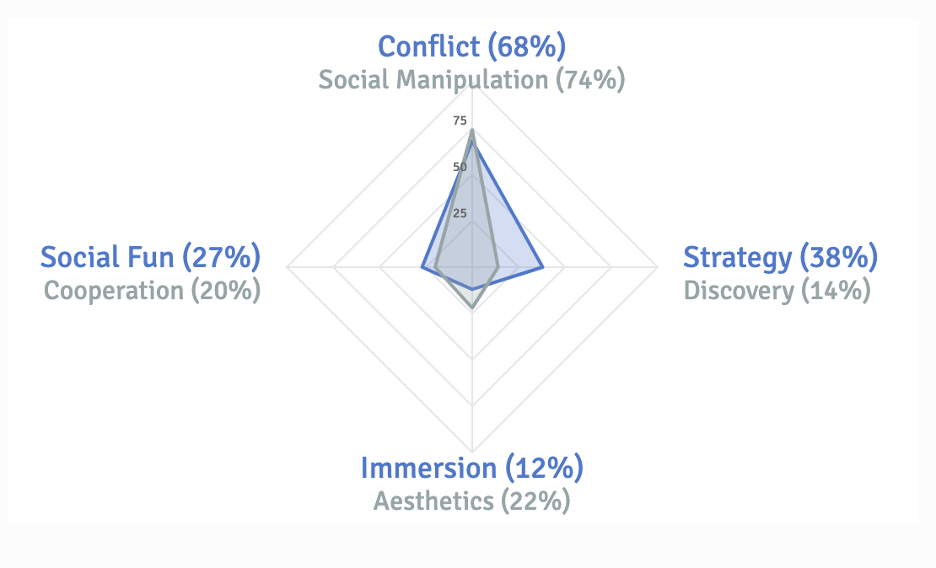As I play many games, board and video games being great examples, I often think to myself, “does this game adequately represent different identities?”. More often than not, I think that games do not adequately represent multiple different identities. This is a problem in many ways.
For the purpose of this assignment, I defined for myself what I thought of different kinds of identities that could be represented. I determined these could be identities such as race, gender, religion, nationality, sexuality, and socioeconomic status, just to name a few. I created a survey that I sent to many people, and I asked them to think about these types of identities as they completed my survey.
The following were some, but not all of the questions, I incorporated in my survey about representation in games: “When a game allows you to choose a character, how do you select which character? Answers can be things such as you like a certain color, you like the character’s outfit, you relate to a character’s identity, etc…”, “What is most important to you when selecting a character in a game?”, “Does a character’s identity influence your decision to select them?”, and “Do games represent different identities as well as they should?”. I selected my questions based on suggestions from the directions of the assignment, but I also included my own questions which I thought were interesting.
Most of the people involved in my research shared that they believe many games do not adequately represent enough/varying identities on the covers of or within a board or videogame. Nearly all people who shared their thoughts with me shared that a character’s identity does influence their decision to select that character. One female-identifying participant shared that more often than not, she picks a female character over male characters if that option is possible. Based on people’s responses to my questions about relatable identities within games, it is apparent that, in most cases, when it comes to identities such as gender and race, players are more likely to pick a player who shares that identity with them.
It is common knowledge that many games do not adequately use characters of varying identities. Many of my participants recognized this. Many games often use white, male, and straight characters. What I learned in my research is that when a player does not see a great portrayal of their own intersectional identity, they will be less likely to play or buy that game. Additionally, if they do play the game, they are likely to pick whichever character is still most similar to their own identity. So if a white female is playing a game with all male characters, according to my research, she is more likely to pick a white male character, instead of a male character of another race.
Personally, I am a white male. I think I do often pick characters similar to my own identity. I think many game players do this. Players feel more comfortable with a character they can relate to. Players are more confident. Alternatively, this is definitely not always the case.
In many games, myself and others do, many times, pick characters who they share few or no identities with. Many participants in my research mentioned this. One participant shared that he typically picks a character similar to him or one that looks cooler. Participants shared that things such as racial and gender identities were not the only things that influenced their decision to select a certain character. Participants shared that their decision to select a character can be influenced by how a character is dressed. People also take into account the stats and abilities of different characters.
In many games, different characters have different abilities or powers. Some of my participants shared that character statistics are sometimes a greater influence when selecting a character than relating to a character’s identity. I believe this shows that identities do not always matter for characters. People like characters with certain abilities and that can influence their character selection decision. This can be followed up with the responses from my question asking if it is important that people see their own identity in characters.
Half of my participants shared they believe it is important to see the representation of different identities in games, and half of my participants think the representation of different identities is not important in games. This surprised me. I expected a greater percentage of participants to think that representation is important in games. It is very important to me that I see many different identities other than my own in games. As a white male, I almost always see a representation of my identity in games, but I do not always see other identities represented as well in games. Having a diversity of character identities is inclusive. It bothers me when I see games that have only a few or no female characters and little racial diversity, as well as little diversity of other kinds of identities.
Representation in games is so important. A diverse representation of varying identities in games allows players to feel accepted and confidently play games. Representation allows players to relate to characters better, and it allows them to better take on the role of their character. Unfortunately, there are many games that do not represent many different identities well. Fortunately, many games are being updated to include greater representation, and many new games are being created with greater representation. Hopefully, all games will have characters that provide equal game experiences for all people.


